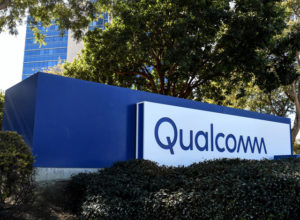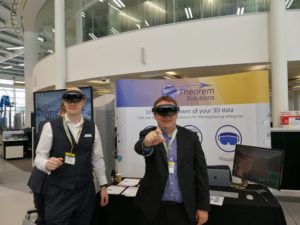Interview with Brian Vogelsang of Qualcomm

AREA: How would you describe Qualcomm’s role in the enterprise AR ecosystem?
Vogelsang: We’re a technology
provider in the ecosystem, delivering chipsets that power AR experiences. Our
Qualcomm Snapdragon platform provides the best silicon/chipset that we can
customize to meet the needs of the XR enterprise ecosystem. You’ll see them in
products today from customers like Vuzix and RealWear. Then there’s the
Microsoft HoloLens 2 that was announced at Mobile World Congress; it uses our Snapdragon
850 Mobile Platform. Vuzix also announced at Mobile World Congress their M400
platform, which is powered by the Qualcomm Snapdragon XR1 platform. Finally,
there are new, emerging OEMs, such as nreal, Realmax, Shadow Creator, and ThirdEye.
Our goal is to optimize technology to put more capability in lighter weight
designs that can drive more immersive experiences at the lowest possible power
levels, but with full connectivity.
AREA: People might have thought that Qualcomm was getting out of AR
when it sold the Vuforia business to PTC three years ago, but the company is
still very much committed to VR and AR, isn’t it?
Vogelsang: That’s correct. We’ve
been working for over a decade in this space. We have a long history of
computer vision expertise and exploring how to build the technology and optimize
it in hardware in ways that will allow more immersive experiences while running
at the lowest possible power. To date, that has been predominantly on smartphones.
However, our long-term vision is that within a decade, we will start
transitioning from a handheld device (smartphone) to a head-worn device or a
sleek AR glass that people use the whole day. And that’s really what we’re
looking at: how do we accelerate that innovation and make those kinds of experiences
happen – initially for enterprises, but long term for consumers.
AREA: So, you expect enterprises to be the early adopters of
wearables, then the consumer market will develop from there?
Vogelsang: That’s right. Today,
in the wearable form factor, there’s a spectrum of devices, from Assisted Reality
devices for remote expert or guided work instructions, to full augmented or
mixed reality devices like HoloLens or Magic Leap. Enterprises are willing to
adopt these technologies if they solve a problem and deliver an ROI – and we’re
excited about that. But long term, we think that the technology needs to get
smaller, lighter weight, and more ergonomic. More like your standard eyeglasses. Because of
these size requirements, that’s going to be particularly challenging
technically. To deliver an immersive experience at the lowest possible power
requires deep systems expertise. That’s right in Qualcomm’s wheelhouse. It’s
going to take a few years for the industry to deliver mass adoption of consumer
class AR eyewear. So for the short term, the enterprise is going to be doing a
lot to drive the market.
AREA: How closely do you work with wearables manufacturers?
Vogelsang: We work really
closely with them on their products and roadmaps, collaborating with them to
achieve their market objectives. There are always tradeoffs as OEMS balance
cost, weight, form factor and ergonomics, optics and display capability, performance,
thermals, and often these impact immersiveness. And so we work really closely
with them to understand their use cases and objectives and then help them with
hardware, software, and support to meet their objectives. We also give them
insight into future technology developments and their future requirements
inform our chipset roadmap. We can’t solve all the problems. Things like
displays and optics as well as camera modules are a big part of the equation in
building an AR device, and while we don’t build those technologies, we work
closely with the suppliers of these components and assist OEMs with integration
through our reference designs and HMD Accelerator Program, which pre-validates
and qualifies components so OEMs can get to market more quickly.
AREA: It seems as if technologies are starting to converge in new
ways: 5G networks, Artificial Intelligence, the Internet of Things, and AR. Do
you get that impression as well?
Vogelsang: Definitely. We see
5G as the connectivity fabric that’s going to allow the mobile network to not
only interconnect people, but also interconnect and control machines and
objects and devices. 5G is going to deliver performance and efficiency that
will enable these new experiences and connect new industries, delivering multi-gigabit-per-second
rates of connectivity at ultra-low latency. Latency is hugely important when it
comes to Augmented and Virtual Reality experiences. And of course, 5G means more
capacity. But AI is already being used in Augmented Reality experiences, enabling
things like head tracking, hand tracking, 3D reconstruction and object
recognition or estimating light. AI is a really important part of that. And I
think 5G also will enable some capabilities to be moved off the device to the
edge of the mobile network – taking some capability and moving it to be
processed at the network edge. And that ultimately will help us enable lighter
weight designs with richer, more immersive graphics at that low power threshold
that we need. So all three – 5G, AI and AR – are coming together. And I think
IoT will be a part of AR in terms of syndicating information contextually about
the environment in an enterprise to an AR experience. IoT will feed the
insights, which will be bubbled up as AR experiences.
AREA: What do you hope to get out of being a member of the AREA?
Vogelsang: Qualcomm’s
customers are OEMs. We don’t sell to end customers, the people who would buy
those devices or experiences. However, we do need to understand what their
needs are so that we can better evolve our technology roadmap to support where
those end users want to go. So, one of the things that excites us about
becoming a member of the AREA is to begin hearing directly from some of the end
customers who are deploying wearable AR technology. We know this is a marathon
and we believe XR – spanning both Augmented and Virtual Reality – will be the
next computing platform. So, we’re taking a long-term view and investing now in
the technology that will enable this market. As a result, we’re very interested
in learning from other AREA members about how the technology is being applied
today to solve concrete problems in the enterprise so we can inform our roadmap.
Those learnings will help us deliver products that can accelerate the pace of innovation
and grow the overall AR wearable market.
We’re doing some trials and
proofs of concept and other things where we get more directly engaged with end
customer use cases. So, being able to collaborate with other AREA members in
that space would be really good. Also, we’d like to get involved in the
committees. We have a human factors team here, and I’d like to get them engaged
with the work that’s being done on the human factors side. While we don’t build
end devices ourselves, we still need to understand as we’re building out
technology how human factors, such as weight, size, or thermals impact the user
experience and ergonomics.
We’d also like to get involved
in requirements. We think we’d really benefit from learning more about requirements
from a horizontal cross-section of the AREA membership. And finally, I think
we’d like to get involved in the marketing side, as well. We would be
interested in using our platform to help tell the story and accelerate industry
adoption.
AREA: Where do you see things headed in XR over the next three to five
years? What are the next big milestones people should be looking for?
Vogelsang: I think that we’ll
see a transition from smart glasses or Assisted Reality experiences to more
Augmented Reality or spatial immersive computing type experiences. Over the
next few years, that transition will really start to accelerate. We’re already seeing
the early promise of what’s to come with technology such as HoloLens or Magic
Leap. I’m really excited about seeing the companies who are deploying smart
glasses or Assisted Reality experiences today start to adopt Augmented Reality
or immersive computing in a much larger way.


